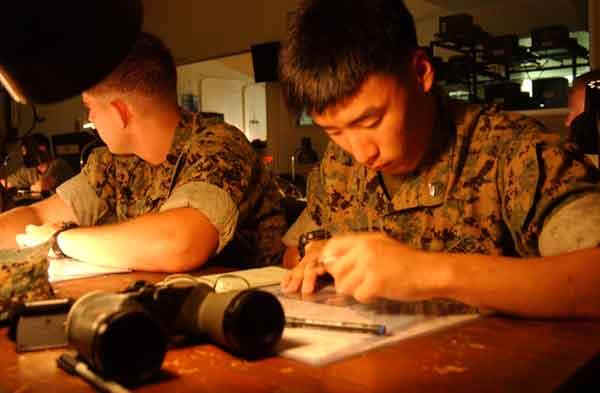Marine Headline News
Recon
trains forward observers to destroy enemy front, Marines
attend Training Set Fire Observation School
CAMP HANSEN,
OKINAWA, Japan — Using slide projectors to display a
simulated enemy front in an attack position, Marines of 3rd
Reconnaissance Battalion, 3rd Marine Division, conducted
artillery support, close air support and naval gunfire
training here May 25-27.
Peering through
binoculars to observe the projected map, the Marines used
protractors and plotted grid coordinates to call for fire at
the Training Set Fire Observation School, 12th Marine
Regiment, 3rd Marine Division.
“The system
displays target silhouettes on a projector screen, on which
they locate their targets by terrain association,” TSFO
systems technician Curt W. Schiller said. “This system
allows Marines to communicate the information to a simulated
support unit and call in artillery fire to the intended
target.”
Artillery fire is
used for protection, according to platoon commander 1st Lt.
Samuel M. Newberger.
If my Marines were
to ever run into the enemy, this would be a way for them to
disrupt and break enemy contact by supporting fire, he said.
The Marines
developed a three-pronged attack to call in the big guns by
honing the grid, polar and shift methods to call for fire.
The grid method
requires the observer to use a map to locate the intended
target and relay a numerical grid coordinate to the unit
providing supporting fire. In the polar method, the observer
determines the direction and distance of the enemy from his
position.
The most complicated
is the shift method because the observer must have a
prerecorded point near the target to determine distance and
range corrections from the known point, Schiller explained.
“Most
of us have seen this before, but it’s one of those things we
need to refresh. The more we practice the easier it is when we
need to do it,” Newberger said.
My Marines think the
grid method is the easiest, because they use the same system
to plot grid coordinates in land navigation, Newberger said.
Once the enemy
position was plotted, the Marines reported the observer
identification, warning order, location of target, description
of target, method of engagement and method of fire and control
to the unit providing the fire support.
“The
artillery battery takes this information and fires down
range,” Newberger said.
Slide projectors
simulated fire, smoke and enemy movement and, along with a
sophisticated sound system, the equipment created a realistic
training environment.
“Artillery fire
can’t be done on Okinawa,” Schiller said. “However, this
saves the Marine Corps money, because (it doesn’t) have to
use live ammunition, and it’s also much safer.”
A basic
understanding of land navigation, range estimation and
communication procedures make calling for fire a fairly easy
skill to develop, according to Cpl. David Y. Kim, a
reconnaissanceman who went through the course.
“This training is
important because it can get Marines out of trouble, or it
could be part of their mission,” Kim said.
Calling for fire is
an important skill for Recon Marines to have at their disposal
because it gives them the capability of heavy firepower at a
moment’s notice. It’s a good collateral skill for any
Marine, Schiller said.

CAMP
HANSEN, OKINAWA, Japan -- Reconnaissanceman Cpl. David Y. Kim
uses a protractor and map to plot grid coordinates of a
simulated enemy position during call for fire training here at
the Training Set Fire Observation School, 12th Marine
Regiment, 3rd Marine Division, May 25-27.
Kim is with 3rd Reconnaissance Battalion, 3rd Marine
Division. (U.S. Marine Corps Photo by Cpl. Ryan Walker)
(Released)